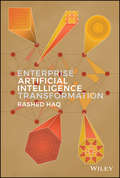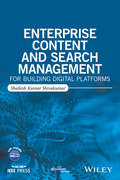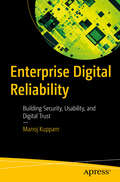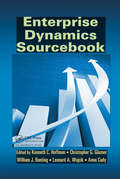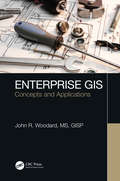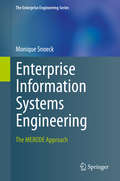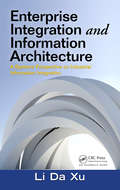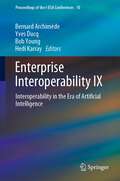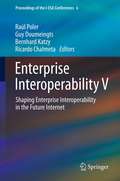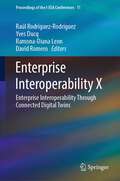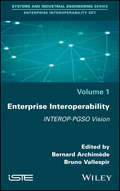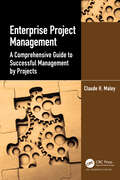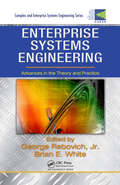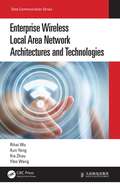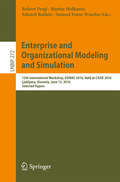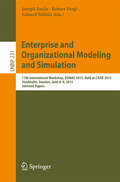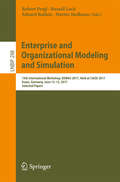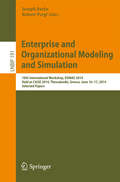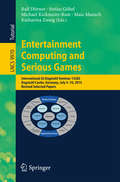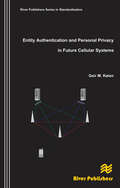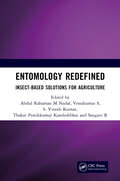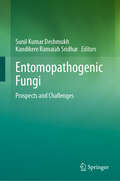- Table View
- List View
Enterprise Architektur entschlüsselt: Ein Praxisorientierter Leitfaden von den Grundlagen bis zur Anwendung
by Dennis SuhariEntdecken Sie "Enterprise Architektur entschlüsselt: Ein praxisorientierter Leitfaden von den Grundlagen bis zur Anwendung“ von Dennis Suhari, ein praxisorientiertes Werk, das die Förderung des Bewusstseins für Enterprise Architektur, die Vermittlung praktischer Erfahrungen und die Unterstützung der Leser bei der erfolgreichen Anwendung ihres Wissens in den Mittelpunkt stellt. Ein Schlüsselelement dieses Buches ist das praxisnahe Fallbeispiel, das einen einzigartigen Einblick in den Aufbau einer Enterprise Architektur von der Geschäfts- über die IT Architektur von Grund auf bietet.Was Sie erwartet:Fundamentale Grundlagen: Ein tiefgreifender Einblick in die essenziellen Grundlagen der Unternehmensarchitektur, um Schlüsselkonzepte und Prinzipien zu vermitteln, die als robuste Basis für die weitere Entwicklung dienen.Modellierung und praktische Tools: Entdecken Sie vielfältige Modellierungsmöglichkeiten und EAM-Tools, die inder Praxis zur Unterstützung der Architekturentwicklung eingesetzt werden.Architekturentwicklung in der Praxis: Anhand des Fallbeispiels der fiktiven Micayu GmbH, basierend auf den umfangreichen Erfahrungen des Autors, erleben Sie die Schritte der Entwicklung einer Unternehmensarchitektur von Grund auf.Zukunftsperspektiven: Ein Ausblick auf die Rolle der Künstlichen Intelligenz und dessen Einfluss auf das Enterprise Architektur Management
Enterprise Artificial Intelligence Transformation
by Rashed HaqEnterprise Artificial Intelligence Transformation AI is everywhere. From doctor's offices to cars and even refrigerators, AI technology is quickly infiltrating our daily lives. AI has the ability to transform simple tasks into technological feats at a human level. This will change the world, plain and simple. That's why AI mastery is such a sought-after skill for tech professionals. Author Rashed Haq is a subject matter expert on AI, having developed AI and data science strategies, platforms, and applications for Publicis Sapient's clients for over 10 years. He shares that expertise in the new book, Enterprise Artificial Intelligence Transformation. The first of its kind, this book grants technology leaders the insight to create and scale their AI capabilities and bring their companies into the new generation of technology. As AI continues to grow into a necessary feature for many businesses, more and more leaders are interested in harnessing the technology within their own organizations. In this new book, leaders will learn to master AI fundamentals, grow their career opportunities, and gain confidence in machine learning. Enterprise Artificial Intelligence Transformation covers a wide range of topics, including: Real-world AI use cases and examples Machine learning, deep learning, and slimantic modeling Risk management of AI models AI strategies for development and expansion AI Center of Excellence creating and management If you're an industry, business, or technology professional that wants to attain the skills needed to grow your machine learning capabilities and effectively scale the work you're already doing, you'll find what you need in Enterprise Artificial Intelligence Transformation.
Enterprise Content and Search Management for Building Digital Platforms
by Shailesh Kumar ShivakumarProvides modern enterprises with the tools to create a robust digital platform utilizing proven best practices, practical models, and time-tested techniques Contemporary business organizations can either embrace the digital revolution—or be left behind. Enterprise Content and Search Management for Building Digital Platforms provides modern enterprises with the necessary tools to create a robust digital platform utilizing proven best practices, practical models, and time-tested techniques to compete in the today’s digital world. Features include comprehensive discussions on content strategy, content key performance indicators (KPIs), mobile-first strategy, content assessment models, various practical techniques and methodologies successfully used in real-world digital programs, relevant case studies, and more. Initial chapters cover core concepts of a content management system (CMS), including content strategy; CMS architecture, templates, and workflow; reference architectures, information architecture, taxonomy, and content metadata. Advanced CMS topics are then covered, with chapters on integration, content standards, digital asset management (DAM), document management, and content migration, evaluation, validation, maintenance, analytics, SEO, security, infrastructure, and performance. The basics of enterprise search technologies are explored next, and address enterprise search architecture, advanced search, operations, and governance. Final chapters then focus on enterprise program management and feature coverage of various concepts of digital program management and best practices—along with an illuminating end-to-end digital program case study. Comprehensive and cutting-edge, Enterprise Content and Search Management for Building Digital Platforms is an invaluable reference resource for creating an optimal enterprise digital eco-system to meet the challenges of today’s hyper-connected world.
Enterprise Digital Reliability: Building Security, Usability, and Digital Trust
by Manoj KuppamGain a comprehensive understanding of digital reliability to ensure consistent, dependable user experiences that foster trust in technology. Part of author Saurav Bhattacharya’s trilogy that covers the essential pillars of digital ecosystems—security, reliability, and usability—this book tackles the challenges of achieving high reliability in complex systems and provides strategies to overcome these obstacles. You’ll start by reviewing the pivotal role of reliability in establishing the foundation of digital trust, essential for the sustainable growth of digital ecosystems. In today's digital landscape, characterized by rapid technological advancements and increasing cyber threats, understanding and addressing reliability issues are paramount. As transformative technologies like AI, blockchain, and quantum computing emerge, grasping these fundamental principles becomes crucial. Enterprise Digital Reliability advocates for collaborative efforts among technologists, policymakers, and society to create digital environments that are innovative, inclusive, safe, and respectful of human values. What You Will Learn Understand the multifaceted concept of reliability in technology and its significance in building digital trust Foster innovation and inclusivity in digital environments and large-scale enterprise and explore strategies to address them effectively Provide a framework for understanding and achieving digital equilibrium Examine operational uptime and consistent user experiences crucial to successful digital platforms Who This Book Is For Cybersecurity Professionals, Technology Developers and Engineers
Enterprise Dynamics Sourcebook
by Kenneth C. Hoffman Christopher G. Glazner William J. Bunting Leonard A. Wojcik Anne CadyRapidly changing market, technological, and organizational environments are forcing government and private sector enterprises to improve services and transform processes. Employing a case study approach, the Enterprise Dynamics Sourcebook presents frameworks and analytical models of the enterprise as a complex system to improve your understanding o
Enterprise GIS: Concepts and Applications
by John R. WoodardThis book defines and discusses how the field of Enterprise Architecture (EA) can be incorporated into the design of Enterprise Geographic Information Systems (EGIS). The objective of EA is to develop a strategic plan that structures an organization’s resources (data, information, people, and assets) into one team that works together to achieve the company’s objectives in an efficient, agile, and adaptable way. It demonstrates how EA concepts can be incorporated within EGIS by improving the system’s efficiency and reliability. Through real-world examples and step-by-step explanations, the reader will reach a comfortable understanding of the theories and methods discussed in the book.
Enterprise Information Systems Engineering
by Monique SnoeckThe increasing penetration of IT in organizations calls for an integrative perspective on enterprises and their supporting information systems. MERODE offers an intuitive and practical approach to enterprise modelling and using these models as core for building enterprise information systems. From a business analyst perspective, benefits of the approach are its simplicity and the possibility to evaluate the consequences of modeling choices through fast prototyping, without requiring any technical experience. The focus on domain modelling ensures the development of a common language for talking about essential business concepts and of a shared understanding of business rules. On the construction side, experienced benefits of the approach are a clear separation between specification and implementation, more generic and future-proof systems, and an improved insight in the cost of changes. A first distinguishing feature is the method's grounding in process algebra provides clear criteria and practical support for model quality. Second, the use of the concept of business events provides a deep integration between structural and behavioral aspects. The clear and intuitive semantics easily extend to application integration (COTS software and Web Services). Students and practitioners are the book's main target audience, as both groups will benefit from its practical advice on how to create complete models which combine structural and behavioral views of a system-to-be and which can readily be transformed into code, and on how to evaluate the quality of those models. In addition, researchers in the area of conceptual or enterprise modelling will find a concise overview of the main findings related to the MERODE project. The work is complemented by a wealth of extra material on the author's web page at KU Leuven, including a free CASE tool with code generator, a collection of cases with solutions, and a set of domain modelling patterns that have been developed on the basis of the method's use in industry and government.
Enterprise Integration and Information Architecture: A Systems Perspective on Industrial Information Integration (Advances In Systems Science And Engineering (asse) Ser.)
by Li Da XuEnterprise solutions have emerged as promising tools for integrating and extending business processes across business functions. Supplying a clear and comprehensive introduction to the field, this book provides a detailed description of enterprise information integration-from the development of enterprise systems to extended enterprise information
Enterprise Interoperability IX: Interoperability in the Era of Artificial Intelligence (Proceedings of the I-ESA Conferences #10)
by Bob Young Bernard Archimède Yves Ducq Hedi KarrayThis book gathers the proceedings of the I-ESA’20 Conference, which was organised by the National Engineering School of Tarbes (ENIT), on behalf of the European Virtual Laboratory, for Enterprise Interoperability (INTEROP-VLab) and the Pole Grand Sud-Ouest (PGSO) and was held virtually in Tarbes, France, in November 2020. It presents contributions ranging from academic research and case studies to industrial and administrative experiences with interoperability. These contributions show how, in a globalised market scenario—where the ability to cooperate with other organisations efficiently is essential in order to remain economically, socially and environmentally cost-effective—the most innovative digitised and networked enterprises ensure that their systems and applications can interoperate across heterogeneous collaborative networks of independent organisations. The focus of this edition of the conference is on interoperability in the era of artificial intelligence and so particular attention is paid to Industry 4.0 and the Internet of Things. The content also addresses smart services and the business impact of enterprise interoperability on organisations. Many of the papers in this tenth volume of the I-ESA Conference proceedings include examples and illustrations to help deepen readers’ understanding and generate new ideas. Offering a detailed guide to the state of the art in systems interoperability, the book will be of great value to all engineers and computer scientists working in manufacturing and other process industries, and to software engineers and electronic and manufacturing engineers working in academic settings.
Enterprise Interoperability V
by Bernhard Katzy Raúl Poler Guy Doumeingts Ricardo ChalmetaWithin a scenario of globalised markets, where the capacity to efficiently cooperate with other firms starts to become essential in order to remain in the market in an economically, socially and environmentally cost-effective manner, it can be seen how the most innovative enterprises are beginning to redesign their business model to become interoperable. This goal of interoperability is essential, not only from the perspective of the individual enterprise but also in the new business structures that are now emerging, such as supply chains, virtual enterprises, interconnected organisations or extended enterprises, as well as in mergers and acquisitions. Composed of over 40 papers, Enterprise Interoperability V ranges from academic research through case studies to industrial and administrative experience of interoperability. The international nature of the authorship contnues to broaden. Many of the papers have examples and illustrations calculated to deepen understanding and generate new ideas. The I-ESA'12 Conference from which this book is drawn was organized by Polytechnic University of Valencia, on behalf INTERVAL, and the European Virtual Laboratory for Enterprise Interoperability (INTEROP-VLab) and sponsored by the International Federation for Information Processing (IFIP) and the International Federation of Automatic Control (IFAC). A concise reference to the state of the art in systems interoperability, Enterprise Interoperability V will be of great value to engineers and computer scientists working in manufacturing and other process industries and to software engineers and electronic and manufacturing engineers working in the academic environment.
Enterprise Interoperability X: Enterprise Interoperability Through Connected Digital Twins (Proceedings of the I-ESA Conferences #11)
by David Romero Yves Ducq Raúl Rodríguez-Rodríguez Ramona-Diana LeonEnterprise Interoperability X presents contributions ranging from academic research and case studies, to industrial and administrative experiences with interoperability. These contributions help organizations to analyse and improve their products and processes in the face of the high degree of uncertainty in the current commercial environment, and to predict their performance. To this end, the contributors exploit digital twin technology that integrates tools from the Internet of Things, artificial intelligence and software analytics. Enterprise interoperability necessarily arises from the processes required to make associated digital twins work together. The book forms the proceedings of the I-ESA’22 Conference, which was organised by the Universidad Politécnica de Valencia, on behalf of INTERVAL and the European Virtual Laboratory for Enterprise Interoperability (INTEROP-VLab), and was held in Valencia, Spain in March 2022. Many of the papers in this eleventh volume ofthe Proceedings of the I-ESA Conferences include examples and illustrations to help deepen readers’ understanding and generate new ideas. Offering a detailed guide to the state of the art in systems interoperability, the book will be of great value to all engineers and computer scientists working in manufacturing and other process industries, and to software engineers and electronic and manufacturing engineers working in academic settings.
Enterprise Interoperability: INTEROP-PGSO Vision
by Bernard Archimède Bruno VallespirInteroperability of enterprises is one of the main requirements for economical and industrial collaborative networks. Enterprise interoperability (EI) is based on the three domains: architectures and platforms, ontologies and enterprise modeling. This book presents the EI vision of the “Grand Sud-Ouest” pole (PGSO) of the European International Virtual Laboratory for Enterprise Interoperability (INTEROP-VLab). It includes the limitations, concerns and approaches of EI, as well as a proposed framework which aims to define and delimit the concept of an EI domain. The authors present the basic concepts and principles of decisional interoperability as well as concept and techniques for interoperability measurement. The use of these previous concepts in a healthcare ecosystem and in an extended administration is also presented.
Enterprise Project Management: A Comprehensive Guide to Successful Management by Projects
by Claude H. MaleyEnterprise Project Management: A Comprehensive Guide to Successful Management by Projects covers the essential and fundamental topics of Enterprise Project Management and Management of Change by projects. It is written for portfolio, program, and project managers, members of the project community, upper-and middle-levelmanagement, functional and operational managers, and all who desire to acquire an understanding of effective change by project management. The book covers in-depth the following important aspects of Enterprise Project Management: Achieving organizational goals Management of programs Benefits realization management Stakeholder management and engagement Project portfolio management (PPM) and the Project Management Office (PMO) The book explains how enterprises can consistently succeed in managing projects by aligning them with Business Goals and clearly defining what needs to be achieved. It shows how to ensure that Enterprise Project Management is fully deployed, and that project management concepts, methods, and techniques are available and utilized to deliver business value and realize benefits. The book helps managers to answer the question, “Are we doing the right projects?” by covering how PPM can ensure project alignment with strategic or operational goals and the efficient use of scarce resources and funding to achieve Objectives and Goals. It also helps managers to answer the question, “Are we doing projects right?” by explaining the critical role of a PMO, which supports excellence in project management by enhancing the proficiencies of Project Managers and providing the foundational tools and techniques for project success.
Enterprise Systems Engineering: Advances in the Theory and Practice (Complex and Enterprise Systems Engineering)
by Brian E. White George RebovichAlthough usually well-funded, systems development projects are often late to market and over budget. Worse still, many are obsolete before they can be deployed or the program is cancelled before delivery. Clearly, it is time for a new approach. With coverage ranging from the complex characteristics and behaviors of enterprises to the challenges the
Enterprise Wireless Local Area Network Architectures and Technologies (Data Communication Series)
by Rihai Wu Xun Yang Xia Zhou Yibo WangThis book has been written with the support of Huawei's large accumulation of technical knowledge and experience in the WLAN field, as well as its understanding of customer service requirements. First, the book covers service challenges facing enterprise wireless networks, along with detailing the latest evolution of Wi-Fi standards, air interface performance, and methods for improving user experience in enterprise scenarios. Furthermore, it illustrates typical networking, planning, and scenario-specific design for enterprise WLANs, and provides readers with a comprehensive understanding of enterprise WLAN planning, design, and technical implementation, as well as suggestions for deployment. This is a practical and easy-to-understand guide to WLAN design, and is written for WLAN technical support and planning engineers, network administrators, and enthusiasts of network technology. Authors Rihai Wu is Chief Architect of Huawei's campus network WLAN solution with 16 years of experience in wireless communications product design and a wealth of expertise in network design and product development. He previously served as a designer and developer of products for Wideband Code Division Multiple Access (WCDMA), LTE indoor small cells, and WLAN. Xun Yang is a WLAN standard expert from Huawei. He has nine years of experience in formulating WLAN standards, and previously served as 802.11ac Secretary, 802.11ah PHY Ad-hoc Co-chair, and 802.11ax MU Ad Hoc Sub Group Co-chair. Mr. Yang oversees technical research, the promotion of standards, and industrialization in the WLAN field, and has filed more than 100 patents. Xia Zhou is a documentation engineer of Huawei's campus network WLAN solution. She has 10 years of experience in creating documents for campus network products. Ms. Zhou was previously in charge of writing manuals for Huawei data center switches, WLAN products, and campus network solutions. She is also the author of Campus Network Solution Deployment Guide and was a co-sponsor of technical sessions such as WLAN from Basics to Proficiency. Yibo Wang is a documentation engineer of Huawei's campus network WLAN solution. He has nine years of experience in creating documents for campus network products. Mr. Wang was previously in charge of writing manuals for Huawei switches, WLAN products, and routers. He was also a co-sponsor of technical sessions such as WLAN from Basics to Proficiency and HCIA-WLAN certification training courses.
Enterprise and Organizational Modeling and Simulation
by Eduard Babkin Robert Pergl Martin Molhanec Samuel Fosso WambaThis book constitutes the refereed proceedings of the 12th International Workshop on Enterprise and Organizational Modeling and Simulation, EOMAS 2016, held in Ljubljana, Slovenia, in June 2016. The 12 full papers presented in this volume were carefully reviewed and selected from 26 submissions. They were organized in topical sections on formal approaches and human-centric approaches.
Enterprise and Organizational Modeling and Simulation
by Eduard Babkin Robert Pergl Joseph BarjisThis book constitutes the refereed proceedings of the 11th International Workshop on Enterprise and Organizational Modeling and Simulation, EOMAS 2015, held at CAiSE 2015, in June 2015 in Stockholm, Sweden. EOMAS was founded with the purpose to become a forum among researchers and practitioners to share their research and practical findings by encouraging the dissemination of research results under a more generic umbrella called enterprise engineering, which encompasses internal factors ranging from organizational complexity to intricacy of business processes and sophistication in workflows as well as external factors and uncertainties such as competition, politics, or the emergence of innovative technologies. The 15 papers presented in this volume were carefully reviewed and selected from 28 submissions. They were organized in topical sections named: enterprise conceptual modeling and simulation; enterprise modeling formal foundation; and enterprise optimization.
Enterprise and Organizational Modeling and Simulation
by Eduard Babkin Robert Pergl Martin Molhanec Russell LockThis book constitutes the refereed proceedings of the 13th International Workshop on Enterprise and Organizational Modeling and Simulation, EOMAS 2017, held in Essen, Germany, in June 2017. The main focus of EOMAS is on the role, importance, and application of modeling and simulation within the extended organizational and enterprise context. The 12 full papers presented in this volume were carefully reviewed and selected from 26 submissions. They were organized in topical sections on formal methods, conceptual modeling, and enterprise engineering.
Enterprise and Organizational Modeling and Simulation
by Robert Pergl Joseph BarjisThis book constitutes the proceedings of the 10th International Workshop on Enterprise and Organizational Modeling and Simulation, EOMAS 2014, held in conjunction with CAiSE 2014 in Thessaloniki, Greece, in June 2014. Tools and methods for modeling and simulation are widely used in enterprise engineering, organizational studies, and business process management. In monitoring and evaluating business processes and the interactions of actors in a realistic environment, modeling and simulation have proven to be both powerful, efficient, and economic, especially if complemented by animation and gaming elements. The 12 contributions in this volume were carefully reviewed and selected from 22 submissions. They explore the above topics, address the underlying challenges, find and improve solutions, and show the application of modeling and simulation in the domains of enterprises, their organizations and underlying business processes.
Entertainment Computing and Serious Games
by Michael Kickmeier-Rust Katharina Zweig Ralf Dörner Stefan Göbel Maic MasuchThe aim of this book is to collect and to cluster research areas in the field of serious games and entertainment computing. It provides an introduction and gives guidance for the next generation of researchers in this field. The 18 papers presented in this volume, together with an introduction, are the outcome of a GI-Dagstuhl seminar which was held at Schlo#65533; Dagstuhl in July 2015.
Entire Vehicle (Commercial Vehicle Technology)
by Michael Hilgers Wilfried AchenbachThe aim of this work, consisting of 9 individual, self-contained booklets, is to describe commercial vehicle technology in a way that is clear, concise and illustrative. Compact and easy to understand, it provides an overview of the technology that goes into modern commercial vehicles. Starting from the customer's fundamental requirements, the characteristics and systems that define the design of the vehicles are presented knowledgeably in a series of articles, each of which can be read and studied on their own. This volume, Entire Vehicle, provides an introduction to the vehicle concept,vehicle variants and the legal framework conditions. The relationships between longitudinal and lateral dynamics are explained in a way that is necessary for understanding both in training and in practice.
Entire Vehicle (Commercial Vehicle Technology)
by Michael HilgersThe aim of this work, consisting of 9 individual, self-contained booklets, is to describe commercial vehicle technology in a way that is clear, concise and illustrative. Compact and easy to understand, it provides an overview of the technology that goes into modern commercial vehicles. Starting from the customer's fundamental requirements, the characteristics and systems that define the design of the vehicles are presented knowledgeably in a series of articles, each of which can be read and studied on their own. This volume, Entire Vehicle, provides an introduction to the vehicle concept,vehicle variants and the legal framework conditions. The relationships between longitudinal and lateral dynamics are explained in a way that is necessary for understanding both in training and in practice.
Entity Authentication and Personal Privacy in Future Cellular Systems
by Geir M. KoienThere are now (Q1 2009) more than 4 billion cellular subscribers in the world and this number is constantly growing. With this in mind it should be clear that use of mobile communication has already become both pervasive and ubiquitous. It has become a global commodity really. Entity Authentication and Personal Privacy in Future Cellular Systems aims at explaining and examining access security as it is found in mobile/cellular systems. A thorough investigation of how access security and personal privacy is handled in the 3GPP system is conducted. This includes both the 2G systems GSM/GPRS and the 3G system UMTS. The emerging fourth generation LTE architecture is also examined. The first part of the book deals exclusively with presenting access security as found in the 3GPP system. Particular attention is given to the authentication and key agreement procedures. The 3GPP systems have evolved and the access security architecture in LTE is substantially more advanced and mature than what you would find in GSM/GPRS, but even the LTE security architecture has its limitations. In part two of the book we go on to examine what is missing from the current cellular access security architectures. Some of the shortcomings found in GSM/GPRS and later UMTS have been partially addressed in LTE, but the burden of backwards compatibility has meant that many issues could not easily be resolved. Free from those restrictions, we shall see that one can provide substantially improved subscriber privacy and enhanced entity authentication, while also avoiding the delegated authentication control that all 3GPP systems have.The design of authentication protocols is discussed in depth, and this would also include looking into the role of formal verification in the design of security protocols.
Entomology Redefined: Insect-Based Solutions For Agriculture
by Abdul Rahaman M Nadaf S Venukumar S. Vinoth Kumar Thakar Pratikkumar Kamleshbhai R SangaviAlthough their significance often goes unnoticed in our day-to-day lives, insects are diverse creatures that play an indispensable role in our ecosystems.This book presents an in-depth discussion about the field of entomology and discusses the anatomy and physiology of insects, their unique body structures, and how they contribute to their diverse ways of life. It also details the mechanisms behind their behaviors – from intricate mating rituals to elaborate communication methods, and explores the vital roles insects play in pollination, nutrient cycling, and maintaining the delicate balance of ecosystems.The subject matter of this book also includes stories of insect discovery, examples of research, and insights into the ongoing efforts to conserve insect diversity in the face of environmental challenges.Print edition not for sale in South Asia (India, Sri Lanka, Nepal, Bangladesh, Pakistan or Bhutan)
Entomopathogenic Fungi: Prospects and Challenges
by Kandikere Ramaiah Sridhar Sunil Kumar DeshmukhThis book brings together the molecular aspects of the pathogenesis of entomopathogenic fungi, various aspects of mycoinsecticide development, and regulatory aspects to highlight the immense contribution of the agricultural sector. The chapters address aspects of entomopathogenic fungi, including host-pathogen interactions (susceptibility and resistance), fungus-insect and fungus-fungus dual interactions, phylogeny and taxonomy, biochemistry, and molecular basis of enteropathogenesis, market potential of entomopathogens, regulatory aspects, bioprospecting of fungi, fungi as crop bodyguards and in disease suppression, and consortia for the control of insect pests and pathogens in single crop systems. Written by experts in academia and industry from Algeria, Brazil, Hungary, India, Italy, Malaysia, Oman, Pakistan, and the United States, the book overviews entomopathogenic fungi used as biological control agents against insect pests and other arthropods, their mode of action, pathogenesis, bioactive metabolites, mycotoxins involved, their mass production, limitations, and agricultural- and environment-related issues. It also includes developing various biopesticide products, with special references to formulations and prospects. In agriculture, crop protection and production depend on insect pests controlled by entomopathogenic fungi. Understanding the pathogenicity, mechanism of action, formulations, and applications of a wide array of entomopathogenic fungi as biopesticides is a valid eco-friendly approach. The book provides advances in pathogenicity, biochemistry, virulence, and interaction that facilitate the application of Beauveria, Metarhizium, and other entomopathogens as potential biopesticides against major insect pests. Developments in bioactive compounds, secondary metabolites, enzymes, and toxins of entomopathogenic fungi have facilitated precise applications and management to target insect pests. Further advances in molecular aspects, the formulation of nanobiopesticides, and biofabricated technology paved the way for insect pest control. This book will be a helpful resource for students, teachers, researchers, scientists, and professionals in the industry working on biological sciences, applied entomology, mycology, zoology, forestry, biochemistry, molecular biology, and nanotechnology.

